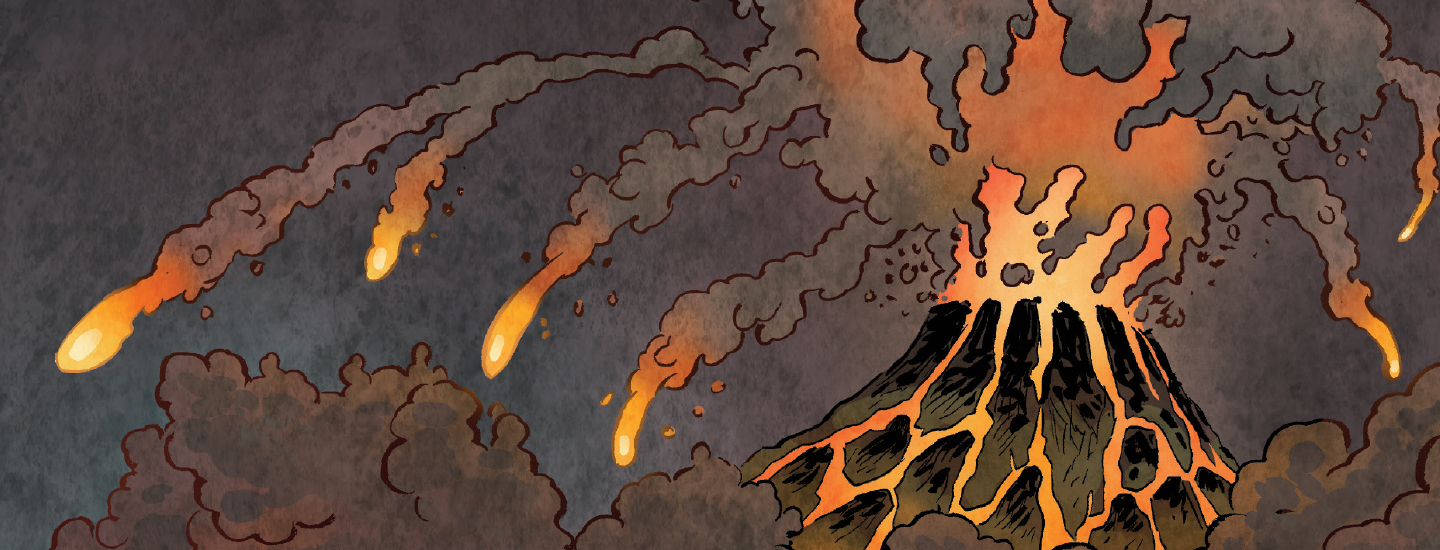The forum of Pompeii is a rectangle 520 feet long by 109 feet wide. What’s its area?
The forum of Pompeii is a rectangle 520 feet long by 109 feet wide. What’s its area?

Illustrations by Joe Flood
STANDARDS
CCSS: 6.G.A.2, 7.G.B.4, 7.G.B.6, 8.G.C.9, MP4, MP5, MP6
TEKS: 6.8.C, 6.8.D, 7.9.B, 8.6.A, 8.7.A
Escape From Pompeii!
YOUR MISSION: As you read the panels, find the area and volume of things around Pompeii, an ancient Roman city near a volcano called Mount Vesuvius. Round all answers to the nearest hundredth on the online answer sheet. Use 3.14 for pi.
A - Forum Holitorium
Grain warehouses and market; currently under construction
B - Temple of Jupiter
Main temple in Pompeii, honoring the highest god in the Roman pantheon
C - Macellum
Main market of Pompeii
D - Sanctuary of the City Lares
Temple that houses lares, or statues of gods and patrons of the city, including the Emperor Augustus
E - Temple of Vespasian
Temple dedicated to Emperor Vespasian—the current emperor
F - Building of Eumachia
Warehouse and trading site for fabrics
G - Comitium
Meeting place for the city council
H - Municipal Offices
Buildings where city officials work, including judges and accountants
I - Basilica
Civic building where the city court meets
J - Temple of Apollo
The oldest temple in Pompeii, honoring Apollo
The forum of Pompeii is a rectangle 520 feet long by 109 feet wide. What’s its area?
The forum of Pompeii is a rectangle 520 feet long by 109 feet wide. What’s its area?
The Macellum has an open center court that’s 121 feet wide and 89 feet long. What’s the area of the Macellum?
The Macellum has an open center court that’s 121 feet wide and 89 feet long. What’s the area of the Macellum?
You want to buy an amphora, or ceramic jar, of olive oil. Pompeii’s olive oil is famous! The jar is an 8.5-inch-tall cylinder with a radius of 1.75 inches. What volume of olive oil did you buy?
You want to buy an amphora, or ceramic jar, of olive oil. Pompeii’s olive oil is famous! The jar is an 8.5-inch-tall cylinder with a radius of 1.75 inches. What volume of olive oil did you buy?
A. The Temple of Apollo sits on top of a raised base that is 95 feet wide, 144 feet long, and 26 feet tall. What’s the area of the base?
A. The Temple of Apollo sits on top of a raised base that is 95 feet wide, 144 feet long, and 26 feet tall. What’s the area of the base?
B. What’s the volume of the temple’s base?
B. What’s the volume of the temple’s base?
There’s a cube-shaped box of cheeses to pick from. Each side is 11 inches long. What’s the volume of the box?
There’s a cube-shaped box of cheeses to pick from. Each side is 11 inches long. What’s the volume of the box?
The Thermopolium you’re in is pretty small. It’s about 11 feet wide by 8.5 feet long. What is the area of the Thermopolium?
The Thermopolium you’re in is pretty small. It’s about 11 feet wide by 8.5 feet long. What is the area of the Thermopolium?
A large cylindrical container holds more olives than you can count! It’s 3.6 feet tall with a radius of 2.25 feet. What’s its volume?
A large cylindrical container holds more olives than you can count! It’s 3.6 feet tall with a radius of 2.25 feet. What’s its volume?
A spherical pumice stone crashes nearby. Its diameter is 3 inches—about the size of your fist! What’s the volume of the rock?
A spherical pumice stone crashes nearby. Its diameter is 3 inches—about the size of your fist! What’s the volume of the rock?
A 17.7-inch-thick layer of ash and pumice has already settled onto the Forum, which is 520 feet long by 109 feet wide. What is the volume of ash?
A 17.7-inch-thick layer of ash and pumice has already settled onto the Forum, which is 520 feet long by 109 feet wide. What is the volume of ash?
A road leading to one harbor is 1,476 feet long and 11.5 feet wide. What is its area?
A road leading to one harbor is 1,476 feet long and 11.5 feet wide. What is its area?
A 40-foot-long section of road by the Forum has already been completely blocked by ash and debris! The road is 8 feet wide and blocked with debris piled 12 feet high. What is the volume of debris on the road?
A 40-foot-long section of road by the Forum has already been completely blocked by ash and debris! The road is 8 feet wide and blocked with debris piled 12 feet high. What is the volume of debris on the road?
Warships from the Roman Navy have arrived to help evacuate! Each ship’s deck is 128 feet long and 13 feet wide. What is the area of the deck?
Warships from the Roman Navy have arrived to help evacuate! Each ship’s deck is 128 feet long and 13 feet wide. What is the area of the deck?
A. What is the area of Mount Vesuvius’s crater?
A. What is the area of Mount Vesuvius’s crater?
B. Using the area of the crater as the base, what was the initial volume of the ash cloud when the eruption began?
B. Using the area of the crater as the base, what was the initial volume of the ash cloud when the eruption began?